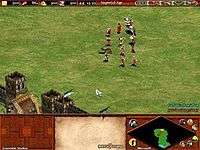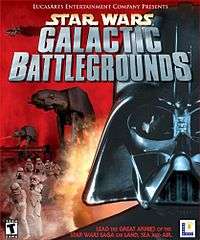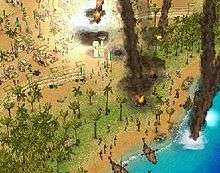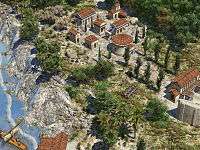Genie Engine
| Developer(s) | Ensemble Studios |
|---|---|
| Initial release | 1997 |
| Type | game engine |
| Website |
www |




The Genie Engine is a game engine developed by Ensemble Studios and used in several popular computer games, such as Age of Empires, Age of Empires II and its expansions (but is not used in other Ensemble Studios games) and Star Wars: Galactic Battlegrounds. Some of those games have been ported to the Apple Mac.
Development
The Genie engine was developed as the basis for Ensemble Studios' first game, Age of Empires which had the development name of "Dawn of Man".[1] The designers received much of their inspiration from the game Civilization, with its proven historical setting; this was noted among reviewers as something positive.[2] Age of Empires was designed by Bruce Shelley,[3] Tony Goodman (in charge of the game's artwork),[4] and Dave Pottinger (in charge of the game's artificial intelligence).[5] The game was described as "Civilization II meets Warcraft II"[6] and this shows in the game's engine design. Like Warcraft it is real time strategy but unlike Warcraft and like Civilization II it is historical and has an isometric perspective.
The design team for the sequel, The Age of Kings, intended to complete the game within a year by using code from the original and reusing the Genie game engine.[7] Several months into the process they found they would not be able to complete a game of the quality they sought in that time. Ensemble Studios informed Microsoft they would need another year and instead created Age of Empires: The Rise of Rome, an easily developed expansion pack of Age of Empires, as a compromise which could be released for Christmas 1998.[8] To help meet the next year's deadline, additional programmers, artists, and designers were employed.[9]
The original Age of Empires had been criticized for its artificial intelligence (AI). Because the original AI did not "cheat"[10] by attributing itself extra resources or using other techniques the human player could not, it was easier to defeat than in many other real-time strategy games. For The Age of Kings, Ensemble Studios attempted to develop a more powerful AI system that did not compromise by cheating. Industry veteran Mario Grimani led Ensemble Studios in the creation of the new system. To overcome another significant objection to Age of Empires—that of path finding—the team completely redesigned the game engine's movement system.[9]
The team was less successful in resolving other issues; programmer Matt Pritchard complained following the release of Age of Empires that there was still no process by which patches could be issued. Extensive cheating in multiplayer games of Age of Empires came as a result of several bugs in the game, which resulted in Microsoft promising Ensemble Studios there would be a patch process for The Age of Kings. On release, there were several bugs that needed immediate attention, but the patch process was not yet ready. The first patch was released 11 months later.[11][12]
Ensemble Studios developed a new terrain system for The Age of Kings, with 3D presentation capabilities that were vastly superior to those of Age of Empires. Pritchard noted an improvement in the team's artistic abilities following their work on the past two games, and he is noted as saying that "AoK became a showcase for their improved talent".[9] However, he complained about the lack of an art asset management tool, while other departments gained new tools and automated procedures to assist in design and play testing.[9][11]
The Age of Kings saw the introduction of a triggers system for its scenario editor. The triggers allow messages to be displayed, or actions to take place, based on pre-set criteria or "events".[13] The scenario editor was also improved by the new AI system. The AI and trigger systems interacted regularly in the single player campaigns.[14] Numerous upgrades were added in The Conquerors but this was mostly in terms of gameplay and not engine advancements.
Star Wars: Galactic Battlegrounds was developed by LucasArts by licensing the Genie game engine from Ensemble Studios. The game, as well as the Clone Campaigns expansion pack, was designed and directed by Garry M. Gaber.[15]
Features
The Genie Engine has several features that are common across all its games, including a scenario editor, campaigns, LAN, serial and TCP/IP multiplayer, background music amongst others. The engine uses an isometric tile set, unlike other real-time strategy engines such as the one used for Warcraft.
Usage
In general, the engine is easy to use. Units can be highlighted by dragging a box around them, or left-clicking. Right-clicking tells a unit to attack another enemy unit or building. Groups of units are remarkably well disciplined in that they adhere far more rigidly to formations in movement and while stationary than units in other game engines.
The computer's A.I. is usually made up of sending "skirmish" type attacks. These usually are characterized by constantly sending a small (but also easily overwhelmed) number of units (usually 1 or two) that attack from range then run away before being attacked. Computer AI will also do this with melee units, with far less effectiveness, as the melee units must come much closer to opposing forces before being able to do damage and withdraw. While innovative it is nearly impossible for a human to effectively counter with non-ranged (also non-siege explained later) units (unless interceptor units are assembled in advance, as they typically will be after a few of these attacks) due to micromanagement issues. It is also almost useless in that it does little more than annoy (albeit continuously) a human player.
Enemy A.I. is extremely effective (whatever the problems of individual unit AI) at negating AOE (area of effect) siege units. When fired upon the A.I. will instantly move to a safe location, effectively nullifying the effectiveness of nearly 1/3 of the available units in the game. A single computer-controlled cavalry archer is capable of dodging 40 cannons or catapults for an extensive period of time. However, it is also common to see computer units move into the line of fire of active AOE units.
The game lacks an "attack through" command. An attack through command orders the selected unit(s) to move to a selected area attacking all units along the way. Instead on games based on the Genie platform, the player must tell the selected unit(s) to stop, then to attack individual units. This frequently causes a mis-click causing all units to stop attacking and move to an unneeded area. It severely reduces the effectiveness of melee units, most notably slower moving infantry. This can be somewhat levied by using patrol command, which sends unit back and forth, while attacking units along the way.
Games using the Genie Engine

Legacy
The games based on the engine have usually been rated highly with Age of Empires having sold over three million copies by 2000[16] and having an average score of 87% from GameRankings.[17] The Age of Kings was a bigger critical success than the first game, with Game Rankings and Metacritic scores of 92%.[18][19] The Age of Empires expansions for both games received slightly less praise but were still very well received.[20][21]Star Wars: Galactic Battlegrounds received generally positive reviews, both from critics[22] and fans.[23][24] GameRankings gave the game a score of 77%, based on 38 media outlets.[25] However, Galactic Battlegrounds did have vocal critics.[26]
The Genie engine was succeeded by the Age of Mythology engine used by the games in that series as well as Age of Empires III and its expansions. The most significant changes being the updated graphics engine and the inclusion of the Havok physics middleware engine[27] and the introduction of home cities.[28]
The design of the Genie engine has been mirrored in later game titles such as Empire Earth,[29] Cossacks: European Wars,[30] Theocracy,[31] and Rise of Nations. Most of these games have also been critically successful.[30][32][33][34] The in-development free software real time strategy game 0 A.D. by Wildfire Games started out as an Age of Empires II modification and boasts many similarities to Age of Empires in its current design on top of its new engine Pyrogenesis.[35] Another free software project is trying to more directly mimic Age of Empires and the Genie engine, written in Gambas.[36][37][38]
References
- ↑ Grossman, Austin (2003). Postmortems from Game Developer. Focal Press. ISBN 1-57820-214-0.
- ↑ "Behind the Scenes". Microsoft.com. Retrieved 2008-09-02.
- ↑ "Behind the Scenes: Bruce Shelly". Microsoft.com. Retrieved 2008-09-02.
- ↑ "Behind the Scenes: Tony Goodman". Microsoft.com. Retrieved 2008-09-02.
- ↑ "Behind the Scenes: Dave Pottinger". Microsoft.com. Retrieved 2008-09-02.
- ↑ Daniel Gies (November 1997). "Build an Empire to Surpass Microsoft's". Game Revolution. Retrieved 2008-02-24.
- ↑ "The Art of Empires" (.doc). Gamasutra. Retrieved 2008-09-22.
- ↑ Matt Pritchard (2000-03-07). "Postmortem: Ensemble Studios' Age of Empires II: The Age of Kings - Catching Up". Gamasutra. Retrieved 2008-09-20.
- 1 2 3 4 Matt Pritchard (2000-03-07). "Postmortem: Ensemble Studios' Age of Empires II: The Age of Kings — What Went Right". Gamasutra. Retrieved 2008-09-20.
- ↑ "Dave Pottinger". Microsoft. Retrieved 2008-09-20.
- 1 2 Matt Pritchard (2000-03-07). "Postmortem: Ensemble Studios' Age of Empires II: The Age of Kings — What Went Wrong". Gamasutra. Retrieved 2008-09-21.
- ↑ "Age of Empires II: The Age of Kings Downloads". Microsoft. Retrieved 2008-09-21.
- ↑ Greg Street (1999-08-27). "Age of Empires II: The Barbarossa Campaign". IGN. Retrieved 2008-09-27.
- ↑ Greg Street (1999-09-10). "Age of Empires II: The Genghis Khan Campaign". IGN. Retrieved 2008-09-27.
- ↑ MobyGames - Garry Gaber
- ↑ Matt Pritchard (2000-03-07). "Postmortem: Ensemble Studios' Age of Empires II: The Age of Kings". Gamasutra. Retrieved 2008-02-01.
- ↑ "Age of Empires". GameRankings. Retrieved 2008-06-17.
- ↑ "Age of Empires II: The Age of Kings". GameRankings. Retrieved 2008-06-17.
- ↑ "Age of Empires II: The Age of Kings (pc: 1999)". Metacritic. Retrieved 2008-06-17.
- ↑ "Age of Empires: The Rise of Rome". GameRankings. Retrieved 2008-06-17.
- ↑ "Age of Empires II: The Conquerors". GameRankings. Retrieved 2008-06-17.
- ↑ List of reviews for Galactic Battlegrounds
- ↑ GameSpot User Reviews for Galactic Battlegrounds
- ↑ Moby Games Profile of Galactic Battlegrounds, with User Reviews
- ↑ GameRankings score for Galactic Battlegrounds
- ↑ Game Revolution Review for Galactic Battlegrounds
- ↑ Steve Butts (2005-03-09). "Age of Empires III". IGN. Retrieved 2008-06-17.
- ↑ "Home City". Ensemble Studios. Retrieved 2008-01-18.
- ↑ Kasavin, Greg (2001-11-13). "GameSpot Empire Earth review". GameSpot. Retrieved 2006-12-30.
- 1 2 "Cossacks: European Wars for PC Review". CNET Networks. Retrieved 2008-08-31.
- ↑ "Theocracy Preview". Eurogamer. Retrieved 2009-11-19.
- ↑ "Empire Earth reviews". Game Rankings. Retrieved 2007-03-16.
- ↑ PRESS ROOM: October 27, 2004 - Rise of Nations: Gold Ships
- ↑ "Stronghold (pc: 2001)". 2009-06-12. Retrieved 2009-06-12.
- ↑ "Pyrogrensis Engine". Mod DB. Retrieved 2009-10-18.
- ↑ "Gambas Genie Project Page". Piga Software. Retrieved 2009-10-18.
- ↑ Iain "Klingoncowboy4" Wilson. "Free AOE?". My Opera Community. Retrieved 2009-10-18.
- ↑ "Age of Empires over WINE". LinuxQuestions.org. Retrieved 2009-10-18.
External links
- Ensemble Studios: the developers of the engine

